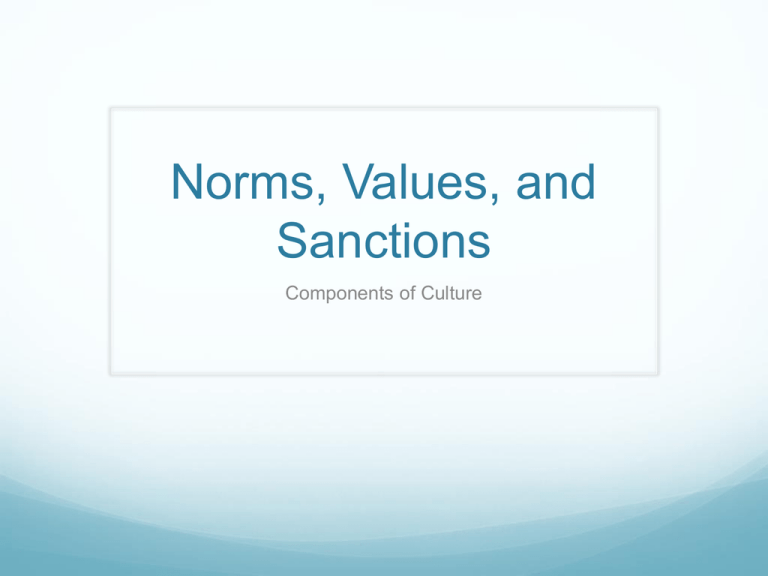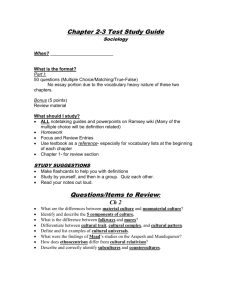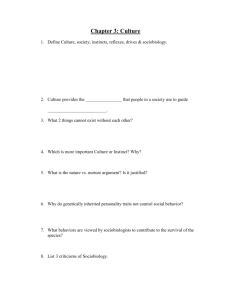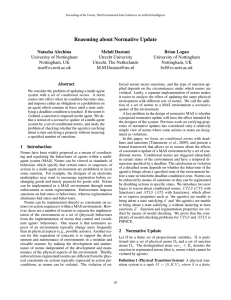Norms, Values, and Sanctions
advertisement

Norms, Values, and Sanctions Components of Culture Competency Goal 2 The learner will demonstrate an understanding of the nature of culture and the role it plays for the individual and for society. Objectives 2.01 Identify and apply the elements of culture. 2.02 Compare and contrast various cultures of the world. 2.03 Explain how the elements of culture form a whole culture. 2.04 Explore the relationship between language and the transmission of culture. 2.05 Analyze the role that culture plays in determining personality. Essential Questions How is culture created and what are the components of culture? How do sociologist view culture from various perspectives? Why is culture important in our changing world? What impact does culture have on people's behavior? How are subcultures created and how do they distinguish themselves from larger cultural groups? What shapes American popular culture? How do sociologists view American culture from various perspectives? How is American culture shaped by our changing world? What impact does culture have on Americans behaviors? Non Material Norms Values Symbols Language Material Technology Values Collective ideas about what is right or wrong, good or bad, and desirable or undesirable in a particular culture. They do NOT dictate how to act, but provide us with criteria by which we evaluate people, objects, and events. American Values What are some American values? The American Value System Ben Franklin listed 13 important virtues [Late1700s] Temperance Silence Order Resolution Frugality Industry Sincerity Justice Moderation Cleanliness Tranquility Chastity Humility Traditional American Values Robin Williams identified 15 values Personal Achievement: Most evident in employment, measured in power and wealth Individualism: Key to personal achievement, positive and negative side Work: Signs of virtue, those who don’t are lazy or immoral Morality: View word in terms of right and wrong Humanitarianism: Quick to help those who are less fortunate Efficiency: Practical and inventive, every problem has a solution Practicality: Tend to judge things based on usefulness and ability to get things done Progress: Believe that through hard work and determination, living standards will continue to improve Material Comfort: Ability of science and technology to make the world a better and more comfortable place Equality: Human equality, equality of opportunity and chance at success Democracy Freedom: Personal freedoms of choice Other Core Values: Nationalism, patriotism, science and rationality, racial and group superiority [James M. Henslin suggested additional values should be added like education, religion, romantic love] Changing Values Self-fulfillment – Commitment to the full development of one’s personality talents and potential Narcissism – Extreme self-centeredness Studies in 1990s noted emergence of other American values, like concern for the environment Ideal vs. Real Culture Ideal: the values you SAY you have I value helping less fortunate people and donating money to humanitarian aid. Real: the values you ACT on Donate money to humanitarian organizations and volunteer time to help Katrina victims. Established rules of behavior or standards of conduct. Values: Provide beliefs about behavior, but do not state how we should actually behave. Norms, on the other hand, do have specific behavior expectations. NORMS Taboo Mores Formal Laws Norms Informal Folkways FORMAL AND INFORMAL NORMS Formal: Written down and involve specific behavioral expectations. Informal: unwritten standards of behavior understood by people who share a common identity. Types of Norms Folkways Informal norms or customs that may be violated without serious consequences. Mores: Strongly held norms with moral and ethical connotations that carry serious consequences Taboo: Mores so strong that their violation is considered to be extremely offensive and even unmentionable. Laws: Formal, standardized norms that have been enacted by legislatures. Enforced by formal sanctions. Norms are enforced by……. SANCTIONS Rewards for appropriate behavior or penalties for inappropriate behavior. Positive Sanction: Reward or Praise. Negative Sanction: Mild disapproval to the death penalty Sanctions: Formal and Informal Formal: Clearly defined and can be administered by persons in certain official positions. Informal: Not clearly defined and can be administered by any member of a group What Would You Do? Clip 2 Get with a buddy! Choose 2 of the following scenarios, for each scenario create a description that reflects the “norm” or typical way to act. Scenarios Behavior at the homecoming dance Volunteering for coalition for the homeless on a weekend. Shopping at Walmart. Behavior on an elevator. Etiquette on a first date. Behavior for an important job interview Behavior at Thanksgiving dinner with your family Behavior in a library while working on a group project Behavior while watching a football game Behavior when walking your dog or going for a run Behavior while babysitting Behavior on an airplane or in the airport In your description you must: Make the situation/scenario evident to the class Display what the “norm” would be in your scenario Also display what the “norm” would NOT be. Give an example of a positive sanction Give an example of a negative sanction Behavior at the homecoming dance. Volunteering for coalition for the homeless on a weekend. Shopping at Walmart. Behavior on an elevator. Etiquette on a first date. Behavior for an important job interview Behavior at Thanksgiving dinner with your family Behavior in a library while working on a group project Behavior while watching a football game Behavior when walking your dog or going for a run Behavior while babysitting Behavior on an airplane or in the airport







